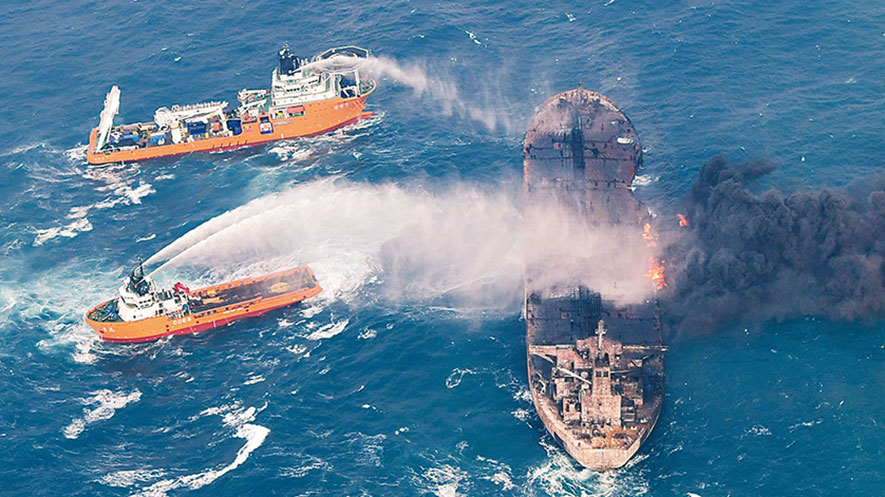According to a maritime policy analyst focused on Asia, territorial disputes between China and Japan delayed the response to the massive Sanchi oil spill and could worsen the already considerable environmental impact of the spill.
“An agreement over the handling of such disasters should be reached to curtail further ecological damage in the future,” Dr. Mark J. Valencia wrote in the South China Morning Post.
“The world’s largest tanker spill in nearly 30 years may be causing a stealthy environmental catastrophe in the East China Sea. Unfortunately, the response to it has been hindered by uncertainties, as well as insufficient capabilities, and lack of leadership and coordination. Even now, its actual and potential environmental impact is still unknown.
“On January 6, the Panamanian-flagged, Iranian-owned tanker Sanchi and the Hong Kong-flagged grain freighter CF Crystal collided about 160 nautical miles east of the Yangtze River mouth. The tanker burned for eight days before sinking. The Sanchi’s entire 32-member crew was lost. The ship spilled some of its 111,000 tonnes of highly volatile natural gas condensate cargo and its heavier 8,450 barrels of bunker fuel.
“Condensate is a very toxic light hydrocarbon. The environmental impact of such a massive spill is unknown. The largest tanker oil spill so far – the 1989 Exxon Valdez catastrophe – was 270,000 barrels, but that was of better understood, more visible and less soluble crude oil. The Sanchi spill was predicted to move southeast into the Japanese-claimed exclusive economic zone and to eventually reach the coasts of Kyushu and Shikoku and perhaps travel further north. But where and when is still unconfirmed.
“Despite being obliged by the UN Convention on the Law of the Sea to protect the marine environment, both China, in whose 200-nautical-mile exclusive economic zone the accident occurred, and Japan, in whose claimed exclusive economic zone the vessel sank, were slow to respond. One reason was uncertainty over how much of the condensate cargo was in the water and how much had burned off in the fire. Also contributing to the delay were lack of knowledge of the environmental effects and the difficulty of cleaning up a substance that was less visible and more difficult to separate from seawater than crude oil.
“Another reason for the delayed response was political tension between China and Japan and their conflicting claims to territory – the Diaoyu/Senkaku islands – as well as overlapping claims to both continental shelves and exclusive economic zones. This dispute includes who has jurisdiction and thus responsibility for environmental protection in the area. Thus both may have initially been concerned that unilateral actions taken or tacit permission given for the other to act may prejudice their claims.
“China and Japan have tried to avoid clashes in their disputed area. They agreed to share fish stocks in defined portions of the area. They established a mutual “prior notification” regime for scientific research there. They also agreed in principle to implement joint development of seabed resources in the central East China Sea. But they have no joint contingency plans to respond to shared environmental emergencies.
“Moreover, those agreements have all but unraveled because of a resurgence of nationalism involving the jurisdictional disputes. Indeed, indicating the seriousness of the political and military situation, the two recently agreed on the implementation of a crisis management and communication mechanism to avoid or mitigate sea and air incidents there. Where is the spill now? The Japanese coastguard has reported black globules on nine islands between Okinawa and Kyushu. If the globules are from the bunker fuel, it could mean that the condensate has already come ashore.
“Vulnerable and valuable marine resources in the East China Sea include fisheries, mammals and coral reefs, including protected ones around Japan’s southernmost islands. The fishery resources of the East China Sea have long been subject to heavy fishing pressures and almost all stocks are exploited. Adding to the concern is that parts of the East China Sea are critical spawning and wintering grounds for some fish species.
“The tainting is likely to have a huge impact on fisheries. Some components of condensate can be carcinogenic. Indeed, scientists have already warned consumers to avoid seafood from the area until the relevant governments have analysed their toxicity and Chinese authorities have banned fishing in the affected area.
“The area is also known to harbor many marine mammals like whales and dolphins, as well as hawksbill turtles, but the effect on these animals is unknown. Adding to the concern is that the area already suffers from chronic pollution from heavy ship traffic and land sources.
“So if this is an environmental disaster, it is a slowly evolving one, the extent of which may not be known for some time. We do know that the response could have been quicker and better. We clearly need more knowledge of the effects of spilled condensate on marine life. But in the interim, to avoid delays in addressing such potential environmental disasters in disputed areas, the political obstacles must be overcome. This particular emergency could provide an opportunity to do so – or to at least jointly plan for the next one.”
Mark J. Valencia is adjunct senior scholar at the National Institute for South China Sea Studies, Haikou, China.





